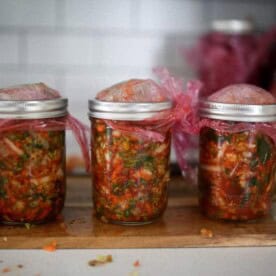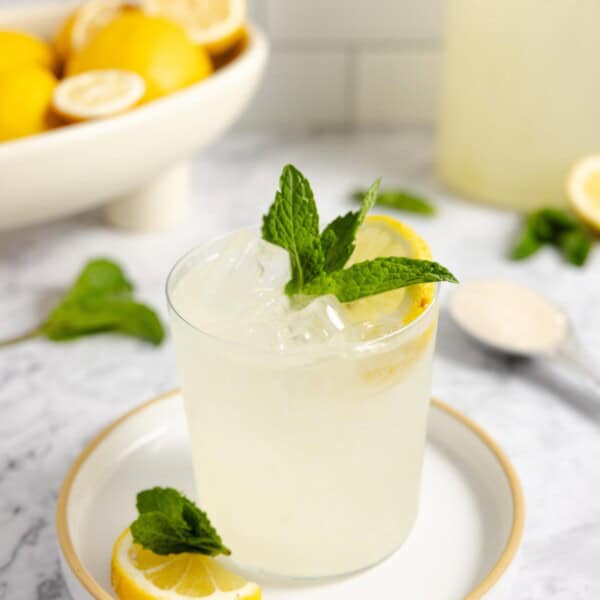Not only are fermented vegetables delicious, they are also rich in probiotics. Learn how to ferment nearly any vegetable and check out some of our favorite fermented veggie recipes at the farmhouse.

This post contains affiliate links, which means I make a small commission at no extra cost to you. See my full affiliate link disclosure here.
You’ll hear me talk about fermented foods quite frequently here, and for good reason. If there is ever such a “health food”, it should be this.
When you think of fermented foods, the first thing that may come to mind is dairy products, such as milk kefir or yogurt.
But the same lacto-fermentation process these dairy products undergo, can be utilized with vegetables. (You can also ferment fruits, too! Learn how to make your own fermented fruits here.)
Lacto-fermentation takes beneficial bacteria that are naturally occurring on vegetables and converts them to lactic acid. And what does that lactic acid bacteria give you? Probiotics!
Why You’ll Love Fermented Vegetables
The health benefits – Lacto-fermentation increases the vitamin and enzyme levels, and improves the digestibility of the fermented food. The gut-healthy probiotics it produces also come with a plethora of health benefits, including helping the immune system, decreasing inflammation, and helping decrease the incidence of certain diseases like heart disease. (source)
Longer storage – Before there was modern day canning, people needed a way to preserve their food to last longer. Lacto-fermentation does just that. Basically, you are allowing the good bacteria (lactobacillus) that is already present on vegetables to take over while salt inhibits the bad bacteria. Fermented vegetables that are properly prepared and stored in a cool, dark place (like the refrigerator) can last at least 4-18 months.
The tangy taste – Not only is it healthy and a great way to preserve summer produce, it also gives you a delicious, tangy taste. The longer it ferments, the tangier it will be.
Ingredients

Vegetable of choice – Most any vegetable can be fermented. Some of my favorites are carrots, garlic, and beets. I’ve included a roundup of my favorite recipes below. You can even add fresh herbs to your ferments for more flavor.
Salt – I prefer a good quality sea salt.
Water – All fermented vegetables require a salt brine. But not all fermented veggies require water to do this. Homemade sauerkraut and homemade fermented salsa, for example, create a brine of their own from their juices just by adding salt. For veggies that do require water, like carrots and garlic, be sure to use filtered water.
Tools You May Need
Fermentation lids – While you can use a tea towel and rubber band, these lids are great if you plan to do a lot of fermenting.
Fermentation weights – You can get creative here. I know some people who use a rock in a Ziplock bag. If you ferment often though, I love these glass fermentation weights.
Glass Jar – You can use any size of wide mouth jar. Since we have a big family and go through a lot of ferments, I usually use 1/2 gallon mason jars.
7 Fermented Vegetable Recipes

Homemade Fermented Pickles

Fermented Carrots

How To Make Fermented Jalapeños

Lacto-Fermented Garlic

Fermented Beets

Fermented Homemade Kimchi

How To Make Sauerkraut
Fermented Veggies FAQ’s
Nearly any vegetable can be fermented. Some of the best vegetables include carrots, cabbage, cauliflower, garlic, and beets. Even green beans can be fermented!
Pickling utilizes an acid and sometimes heat in order to create that classic pickled flavor. Fermentation does not require an acid or heat. Unlike pickled veggies, fermented vegetables provide gut-healthy probiotics.
The “lacto” portion of lactose fermentation refers to Lactobacillus, a species of beneficial bacteria which are present on the surface of all plants. This beneficial bacteria converts lactose or other sugars into lactic acid.
Basically, you are allowing the good bacteria (lactobacillus) that is already present on vegetables to take over while salt inhibits the bad bacteria. The good bacteria then grow with a little time at room temperature.
Depending on the type of food you are fermenting, it will take a few days to a few months. Follow recommendations on specific recipes. Once the process is complete, you typically store the foods in the refrigerator to slow down the fermentation process.
Fermented foods that are properly prepared and stored in a cool, dark place (like the refrigerator) can last at least 4-18 months.
Always look for any signs of mold, an even color throughout, and make sure it still looks edible. Use your nose to see if it still smells as it should, and doesn’t have a bad smell. Check to make sure the texture is still good, and not mushy. You can always taste it to make sure it tastes good.
More Fermented Recipes From the Farmhouse
- Homemade Fermented Ketchup
- Fermented Hot Sauce
- Fermented Balsamic Blueberry Vinaigrette
- Water Kefir
- Berry Kefir Smoothie
If you try any of these recipes and love them, I would love it if you could come back and give them 5 stars! Tag me on Instagram @farmhouseonboone.










I made the fermented salsa recently. The first batch came out fine. For the second batch, I left it on the counter for a little under 2 days. After I refrigerated it, it would sting my tongue whenever I ate it. Is this something that you have experienced before with any ferments? Did I ferment it to long? Should I throw it away? Thanks!
Hi Lisa, I’m excited to start fermenting vegetables! I want to try asparagus, and I just bought a bunch from the grocery store (not organic or anything). May I wash them before fermenting or will that remove all the beneficial bacteria? I just don’t want the harmful bacteria still on there. 😬
Definitely wash them first! Especially if they are not organic.
New to the lácto fermentation world. Can you use red Himalayan sea salt or other sea salts? Also when you say servings are you using the general rule of a fist is a serving of vegetables? Thanks!
Yes, that is fine! Yes, that’s about what I do when I serve vegetables.
Honestly I’m so thankful for you sharing the technique of fermentation. Maybe it extend my life longevity because of your fermentation you shared to me. Again sincerely thank you so much
How does room temp affect the fermentation? Does it ferment more quickly in a warm room?
Do you have a particular brand or type of salt you prefer for fermenting?
A non-iodized salt. I like to use Redmond’s Real Salt!
Hello,
I’m not educated on fermenting. How long would the vegetables last in the fridge? Thank you for your videos.